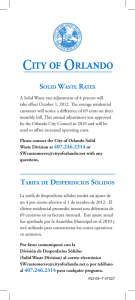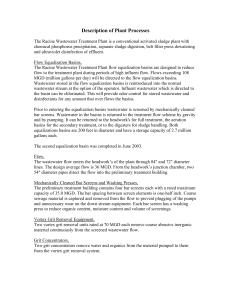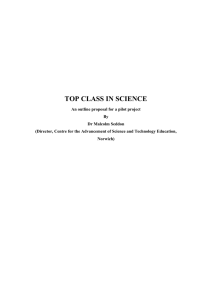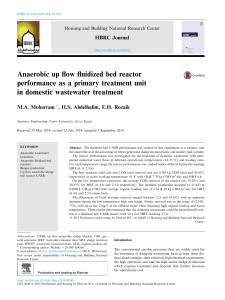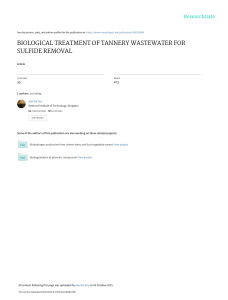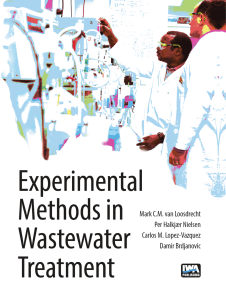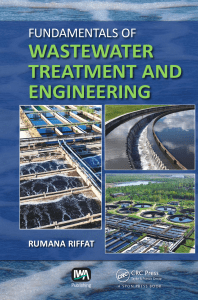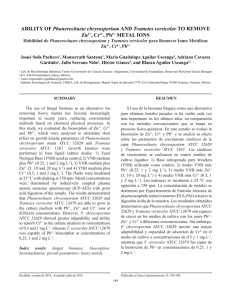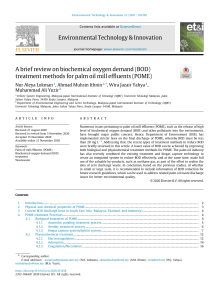REPLACEMENT OF FRESH WATER USE BY FINAL EFFLUENT
Anuncio
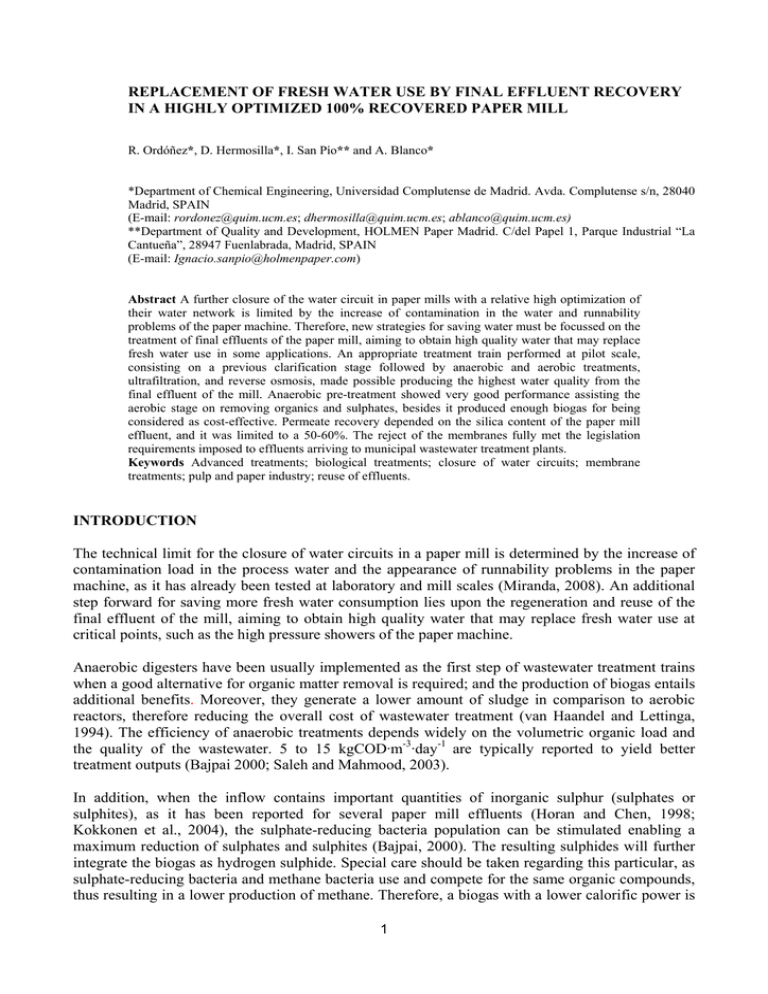
REPLACEMENT OF FRESH WATER USE BY FINAL EFFLUENT RECOVERY IN A HIGHLY OPTIMIZED 100% RECOVERED PAPER MILL R. Ordóñez*, D. Hermosilla*, I. San Pío** and A. Blanco* *Department of Chemical Engineering, Universidad Complutense de Madrid. Avda. Complutense s/n, 28040 Madrid, SPAIN (E-mail: rordonez@quim.ucm.es; dhermosilla@quim.ucm.es; ablanco@quim.ucm.es) **Department of Quality and Development, HOLMEN Paper Madrid. C/del Papel 1, Parque Industrial “La Cantueña”, 28947 Fuenlabrada, Madrid, SPAIN (E-mail: Ignacio.sanpio@holmenpaper.com) Abstract A further closure of the water circuit in paper mills with a relative high optimization of their water network is limited by the increase of contamination in the water and runnability problems of the paper machine. Therefore, new strategies for saving water must be focussed on the treatment of final effluents of the paper mill, aiming to obtain high quality water that may replace fresh water use in some applications. An appropriate treatment train performed at pilot scale, consisting on a previous clarification stage followed by anaerobic and aerobic treatments, ultrafiltration, and reverse osmosis, made possible producing the highest water quality from the final effluent of the mill. Anaerobic pre-treatment showed very good performance assisting the aerobic stage on removing organics and sulphates, besides it produced enough biogas for being considered as cost-effective. Permeate recovery depended on the silica content of the paper mill effluent, and it was limited to a 50-60%. The reject of the membranes fully met the legislation requirements imposed to effluents arriving to municipal wastewater treatment plants. Keywords Advanced treatments; biological treatments; closure of water circuits; membrane treatments; pulp and paper industry; reuse of effluents. INTRODUCTION The technical limit for the closure of water circuits in a paper mill is determined by the increase of contamination load in the process water and the appearance of runnability problems in the paper machine, as it has already been tested at laboratory and mill scales (Miranda, 2008). An additional step forward for saving more fresh water consumption lies upon the regeneration and reuse of the final effluent of the mill, aiming to obtain high quality water that may replace fresh water use at critical points, such as the high pressure showers of the paper machine. Anaerobic digesters have been usually implemented as the first step of wastewater treatment trains when a good alternative for organic matter removal is required; and the production of biogas entails additional benefits. Moreover, they generate a lower amount of sludge in comparison to aerobic reactors, therefore reducing the overall cost of wastewater treatment (van Haandel and Lettinga, 1994). The efficiency of anaerobic treatments depends widely on the volumetric organic load and the quality of the wastewater. 5 to 15 kgCOD·m-3·day-1 are typically reported to yield better treatment outputs (Bajpai 2000; Saleh and Mahmood, 2003). In addition, when the inflow contains important quantities of inorganic sulphur (sulphates or sulphites), as it has been reported for several paper mill effluents (Horan and Chen, 1998; Kokkonen et al., 2004), the sulphate-reducing bacteria population can be stimulated enabling a maximum reduction of sulphates and sulphites (Bajpai, 2000). The resulting sulphides will further integrate the biogas as hydrogen sulphide. Special care should be taken regarding this particular, as sulphate-reducing bacteria and methane bacteria use and compete for the same organic compounds, thus resulting in a lower production of methane. Therefore, a biogas with a lower calorific power is 1 produced (Hao et al., 1996; Hulshoff et al., 1998; Lens et al., 1998). Sulphide inhibition is most likely to occur in wastewaters with low COD concentrations and COD/SO42- relations lower than 7.5 (Bajpai, 2000). Furthermore, anaerobic process efficiency is also widely dependent on the temperature of the reactor. In general, a mesophilic range of temperatures (20-45ºC) allows a higher stabilization of the waste and smaller-sized digesters (van Haandel and Lettinga, 1994; Bajpai, 2000; Luostarinen et al., 2007). Finally, the optimum pH value for anaerobic systems ranges from 6.5 to 7.5 (Cajigas et al., 2005). Below pH=6.5, methanogenic bacteria slow down their growth, showing serious problems below 6.0. On the other hand, although these microorganisms can grow at pH>7.5, their metabolism is much reduced. In general, pH is kept at the right level by the existent alkalinity in the wastewater. It is widely considered that anaerobic treatment alone is not enough effective if soluble BOD5 must be lower than 20 mg·L-1, and/or removal efficiencies higher than 95% (Eckenfelder et al., 1988), as it happens when biofouling phenomena must be reduced in posterior membrane filtration treatments aiming to remove excessive salts contents and final disinfection (e.g. TOC and COD values below 3 and 10 mg·L-1, respectively, were recommended for water feeding RO membranes by Dow Liquid Separations, 2005). But an anaerobic reactor can be highly cost-effective as the pre-treatment of an aerobic stage, which, on the contrary, consumes energy (Nguyen, 2007). In particular, activated sludge systems work applying the principle of biological oxidation to the organic fraction of the wastewater inside the aeration tank. Microbial cells are separated in a secondary clarifier, and a fraction is re-circulated into the reactor in order to keep a solid concentration of 3-5 g·L-1 (Andreadakis, 1993; Nguyen, 2007). These easier-to-operate biological systems produce very good organic removals at pH=8.5 (Eckenfelder et al., 1988). Regarding the implementation of membrane filtration systems after biological treatments, microfiltration (MF) or ultrafiltration (UF) are the necessary pre-treatment for the wastewater inflowing a reverse osmosis (RO) unit, especially when the content of suspended solids is relatively high (Speth and Reiss, 2005). While MF is suitable for removing suspended solids, including larger microorganisms like protozoa and bacteria, UF may even remove viruses and organic macromolecules down to approx. 0.02 μm (Van der Bruggen et al., 2003). In general, UF is highly used in treatment plants reclaiming wastewater worldwide; and membrane bioreactors (MBRs) are taking advantage in different urban and industrial applications (Dialynas and Diamadopoulos, 2009). While encased dead-end mode UF systems may entail a lower operational cost, MBRs operate in a submerged design, which requires low trans-membrane pressures (TMP), thus minimizing the effects of fouling. In addition, as they are based upon a variation of the conventional activated sludge process, where MF or UF membranes are installed, MBR technology do not show problems related to filamentous bulking (Yujiao et al., 2007), which is so usual in paper mills (Thompson et al., 2001; Thompson and Forster, 2003). Moreover, incorporating membrane treatments make the reactors run with a higher dried solid concentration (8-15 g·L-1) than conventional activated sludge (3-5 g·L-1). Therefore, they produce less biological sludge. These properties also lead to lower hydraulic retention times and/or volumes required to perform the biological treatment in comparison to conventional systems (Stephenson et al., 2000; Melin et al., 2006). According to the maximum water quality required for replacing fresh water, RO systems are recommended to be placed as the final step of any treatment train aiming to recover final effluent wastewater from the paper mill and reuse it as process water. Final RO treatment ensures conductivity reduction and total pathogen removal. However, scaling and fouling phenomena may cause decline in water production rates, low permeate quality, unsteady-state operation conditions, 2 and serious damages in the membranes (Al-Ahmad et al., 2000; Ghafour, 2002). Therefore, research pilot trials including RO stages as final disinfection and treatment steps of the treatment trains should analyse results paying special attention to this particular. This manuscript shows the results obtained in a pilot plant study, considering two alternative treatment trains based upon the above described technologies, developed in HOLMEN Paper Madrid (Spain), with the scope of comparing their performance in recovering the final effluent of the mill for its reuse in critical places within the process requiring high water quality. Several aspects, such as conversion capacity, purification efficiency, and performance flexibility of the pilot systems, and their different processes, are assessed. Brief description of the water network, consumption and quality requirements inside the paper mill HOLMEN Paper Madrid is a paper mill located in Madrid (Spain) that produces 470,000 T·year-1 of newsprint (NP) and light-weight coated (LWC) paper from 100% recovered material. This company has recently made a special great effort to optimize their internal water network and water use, considering the incorporation and application of the best available technologies to reuse and recover water within its processes, leading to a current water consumption of 8.5 m3 of fresh water per tonne of paper produced, which is one of the lowest values reported inside the European Union for this type of product. Moreover, this water consumption level is below the values of 10-20 m3·T-1 referred in the Reference Document on Best Available Techniques (BREF) in the Pulp and Paper Industry (Institute for Prospective Technological Studies, IPPC Bureau, 2001). Nevertheless, the mill has arrived to the technical limit for the closure of its water circuits, as determined by the proper runnability of the paper machine (Miranda, 2008). The greatest fresh water consumption inside the mill is hold by the high pressure showers of the paper machine, which are needed to clean the wires of the formation and press section in continuous. In order to avoid scaling, corrosion, biofouling, and losses in retention aid efficiencies, the minimum water quality requirements that must be met in this process are: conductivity <500 μS·cm-1, suspended solids <5 mg·L-1, sulphates <100 mg·L-1, silicates <40-50 mg·L-1, chloride <50 mg·L-1, hardness <200 mgCaCO3·L-1, alkalinity <100 mgCaCO3·L-1, iron <0.1 mg·L-1, aluminium <0.1 mg·L-1, magnesium <15 mg·L-1, manganese <0.05 mg·L-1, nitrates <1 mgNO3·L-1, and total phosphorous <0.2 mg·L-1 (Blanco et al., 1996; Hulkko et al., 1999; Joore et al., 2000; Hubbe, 2007). Furthermore, water quality criteria must also consider health risks derived from the occasional spread out of process water as aerosols that may reach workers; and, in addition, the final effluent of the mill must fulfil the requirements set by the legislation in force. The design of a wastewater treatment aiming to recover final effluent of the mill should produce a water quality meeting all these requirements. MATERIAL AND METHODS In such a paper mill as the above introduced with a highly optimized water network, the deinking line is divided in two separate water loops to minimize the carry-over of contaminants to the paper machine. The accumulation of detrimental substances in water loops is avoided by the presence of internal treatments, e.g. dissolved air flotation units (DAF). This treatment, in combination with the addition of coagulants and flocculants, achieves the removal of an important quantity of colloidal and dissolved matter (Miranda et al., 2008). The pilot plants were designed to treat the outlet wastewater from the DAF unit placed in the first water loop, which is reported as the most contaminated water of the mill, and the one sent to the wastewater treatment plant as final effluent. The most important parameters that characterize this wastewater are showed in Table 1. 3 Table 1. Characterization of the treated wastewater (i.e. outlet effluent from the DAF placed at first water loop in the mill). Minimum pH Average Maximum 6.9 7.3 7.8 25 30 35 1.8 2.8 3.9 1500 2600 3500 1000 2200 3000 BOD5, mg·L TSS, mg·L-1 Ca, mg·L-1 SO42-, mg·L-1 600 40 56 360 1200 350 106 495 1600 900 145 720 SiO2, mg·L-1 60 170 240 95 110 150 Total N, mg·L 0.0 4.8 9.7 -1 0.0 0.6 1.0 -390 -277 -61 0.2 0.5 1.1 T, ºC -1 Conductivity, mS·cm -1 Total COD, mg·L -1 Dissolved COD, mg·L -1 - Cl , mg·L -1 -1 P-PO4, mg·L Redox, mV Absorbance at 254nm Two pilot plants with a capacity of 1 m3·h-1 were installed in parallel to compare two different types of pre-treatments before the RO units. Pilot plant A (Figure 1) consisted of a biological double step (anaerobic + aerobic) followed by UF and RO. Pilot plant B (Figure 2) consisted of an anaerobic reactor followed by a MBR and a final RO. Figure 1. Flow diagram of the pilot plant A. As the inlet water carried an important amount of suspended solids (mainly fibres), both plants included a first clarifying (Plant A) or screening (Algas microfilters, Plant B) stage to remove heavy particles greater than 30 µm. The suppliers of the pilot plants designed and provided these devices 4 as suitable solutions for removing suspended solids before inflowing the wastewater to the anaerobic stage. Although both systems accomplished their function, the filtration device resulted more efficient. Furthermore, in order to ensure a stable anaerobic reactor operation, both pilot plants were also equipped with a pre-acidification step, and a pH control system that supplied NaOH or HCl in case of pH deviations from the set values (pH=6.5). Phosphoric acid (H3PO4, as source of phosphorous) and urea (as source of nitrogen) were added as nutrients to feed the microorganisms before the anaerobic step in a BOD:N:P ratio of 100:5:1. While a modified IC (internal circulation) anaerobic reactor was installed in plant A, an EGSB (expanded granular sludge bed) type was implemented in plant B. Both anaerobic reactors worked with an organic volumetric load range of 7-15 kgCOD·m-3·day-1. The generated biogas was passed through a counter to record the total quantity produced. Its composition was measured by the following methods: GI/PO/MAM/07, GI/PO/MAM/30 and GI/PO/MAM/33. Figure 2. Flow diagram for the pilot plant B. The effluent of the anaerobic reactor in pilot plant A was discharged into an activated sludge reactor divided in three successive cascade basins through which the water flowed in series. This configuration improves the sedimentation characteristics of the sludge, as the cascade causes the formation of highly-loaded stressed zones and lower-loaded zones, favouring biogenesis, which prevents the formation of bulking sludge (Möbius, 1989). An aeration system continuously supplied oxygen to the wastewater (≥2 mgO2·L-1). The concentration of solids in the mixed liquor (MLTSS) was kept between 2-3 g·L-1. A secondary sedimentation served for the separation of the activated sludge from the wastewater coming out from the biological stage. The settled sludge was controlled with a return pumping station which droved sludge back to the aerobic tank periodically. In this way, the concentration of the activated sludge was kept as constant as possible. The clarified water was then sent to a dead-end mode UF membrane system made of polyvinylidene fluoride (PVDF) hollow fibres, which removed particles greater than 0.04 µm. The normal cleaning cycle for this UF system consisted in the use of a low pressure air scouring and the subsequent drainage of the rejected particles and bacteria. Backwashes were typically initiated every 22-30 minutes and the cycles lasted 3 minutes maximum. When transmembrane pressure (TMP) reached 110 kPa, chemical cleanings in place (CIP) with sodium hypochlorite at pH=9-9.5 and T=35ºC were performed. 5 Finally, the RO system installed in pilot plant A was built with three membrane modules of spiral wounded polymer with a pore size in the range of 0.0001µm. The modules were operated in crossflow conditions. When the permeate flux decreased about a 10%, CIP operations were performed by applying citric acid at pH=2 and T=35ºC first, and then, an alkaline product (Ultrasil 10®) at pH=910 and T=35ºC. On the other hand, the effluent outflowing from the anaerobic reactor of pilot plant B was discharged into a MBR of PVDF hollow-fibre membranes at a flow rate of 400 L·h-1. This pilot treatment worked at a food/microorganisms ratio (F/M) of 0.15 kgCOD·kgMLTSS-1 in a first stage, and at 0.18 kgCOD·kg·MLTSS-1 in a second one, so a shorter hydraulic retention time (HRT) was achieved. MLTSS were kept constant between 8 and 10 g·L-1. The membranes ran at 4 different flow rates: 10, 12, 15 and 17 L·m-2·h-1. Two different routine cleaning processes were applied during this pilot test: (1) 25 seconds-long backwashes were performed every 6 min; and (2) weekly maintenance cleanings consisting of a first 40 min-long oxidizing step with NaOH (1 g·L-1), and followed by an acid step performed supplying citric acid (2 g·L-1) and adjusting to pH=2.5-3.0 by HCl addition. Finally, a recovery cleaning (RC) was performed adding sodium hypochlorite (2 g·L1 ) at pH=12 (adjusted with NaOH), and hydrochloric acid then, at pH=2.5, in order to recover the initial permeability values at the end of the trials. The water outflowing from the MBR was sent to the corresponding two-step RO section, formed from spiral wounded polymer membranes too. The first RO unit was operated as a first membrane treatment simulating a big membrane train. The second one was operated as a last membrane treatment by internal recirculation of the reject. Antiscalant was supplied at the entrance of the first RO stage (4-6 mg·L-1). Both units ran at constant pressure. The first one operated at 7-8 bar with an average recovery of 20%; and 8-9 bar were applied in the second one, achieving an average recovery of 35%. All water analyses were carried out according to the Standard Methods for Examination of Water and Wastewater (Eaton et al., 2005). Biodegradability was measured according to ZahnWellens/EMPA Test (OPPTS 835.3200, EPA 1998). RESULTS AND DISCUSSION Anaerobic treatment was able to remove 50% and 70% of the initial BOD5 and COD, respectively, in both pilot plants (Figures 3 and 4); even though the presence of sulphates in the effluent (Table 1) is high in relation to COD values. In accordance to the achieved reductions in BOD5 and COD, these treatments produced enough biogas to be considered as cost-effective (Table 2) Moreover, sulphate was removed to make the effluent fulfil the requirements set by current regional legislation (Law 10/1993, 26th of October, Madrid Region) for the final reject from the membranes (<1000 mgSO42-L-1). In order to correctly assess sulphate removal results, we have to take into account what it really happens in the anaerobic stage. While a fraction of the sulphates (≈30%) is removed as hydrogen sulphide integrating the biogas (Table 2), other greater part (≈70%) is reduced to other sulphurous species that are sent to the aerobic stage; resulting that there is an apparent total removal (95%) of sulphates after the anaerobic treatment. These reduced sulphurous species are then oxidized back to sulphate along the aerobic stage, thus revealing the actual sulphate removal achieved in the anaerobic treatment, which resulted about a 30% in both pilot plants (Figures 3 and 4). 6 100 % Removal 80 CODs BOD5 SO42- 60 40 20 0 Anaerobic Anaerobic+Aerobic Figure 3. Pilot Plant A: Removal efficiencies of soluble COD, BOD5 and SO42- (mean ± standard deviation) for the biological treatments stage. 100 CODs BOD5 % Removal 80 SO42- 60 40 20 0 Anaerobic Anaerobic+MBR Figure 4. Pilot Plant B: Removal efficiencies in soluble COD, BOD5 and SO42- (mean ± standard deviation) for the biological treatments stage. In general, the removal of organic contaminants by the anaerobic stage was very stable in both plants throughout the whole period of time the pilot trials were running (about three months). Furthermore, it is important to report that, in order to study the pH behaviour, the pH control was 7 turned off in both pilot plants and it was kept under control by the pre-acidification step without problems. Particularly, operating conditions at higher pH values were also studied, simulating an accidental spill of alkali. When the pH was increased to about 9.0 during 2 days, the bacteria were inhibited in both plants, but did not die. 10 days afterwards, the treatments began to work as before the spill of alkali was simulated (Figure 5). Table 2. Biogas composition and flow of the anaerobic reactors in the pilot plants. Parameter Units H2S CH4 CO2 CO N2 O2 H2 HF HCl Particulate matter Silicon Biogas flow Pilot plant A Pilot plant B 1758 80.1 13.8 <0.03 3.4 2.7 <0.15 <0.04 <0.04 <0.83 <0.004 - 4956 87.7 11.4 <0.03 <0.1 0.9 <0.15 <0.04 <0.04 0.83 <0.004 0.21 -3 mg·m % % % % % % mg·m-3 mg·m-3 mg·m-3 mg·m-3 m3·h-1 A t n a l P l a v o m e r D O C H p % B t n a l P l a v o m e r D O C % 12 75 60 pH 10 9 45 8 30 7 % COD removal 11 alkali spill simulation 15 6 -10 -5 0 5 10 15 20 Time (day) Figure 5. Time course evolutions of COD removal and pH close-before and after an alkali spill (pH=9, time = 0 days). 8 As part of the biodegradable COD and BOD5 were not removed in the anaerobic step, the aerobic stage was confirmed (Figures 3 and 4) as necessary before feeding the membrane treatments. In fact, biodegradable fatty acids were present in the solution after the anaerobic step in both plants (120 ± 50 mg·L-1), and therefore they must be removed in a complementary biological treatment stage. Finally, COD and BOD5 removals were acceptable after the aerobic treatment (Figures 3 and 4) to further perform a posterior membrane treatment; and no significant fatty acids contents were present in the wastewater (Table 3). Moreover, biodegradability measurements showed that the remaining COD in the out-flowing water from the biological treatments was not biodegradable at all (Figure 6). Table 3. Characteristics of the treated wastewater after the biological treatments. Parameter pH TDS Dissolved COD BOD5 Conductivity VFA SO4 SiO2 Units Pilot plant A Standard deviation Pilot plant B Standard deviation 7.91 2538 450 43 2907 5.21 383 144 0.26 674 160 24 392 2.34 104 57 7.82 2487 374 17 2914 3.24 333 138 0.37 578 97 9 890 1.79 138 55 -1 mg·L mg·L-1 mg·L-1 µS·cm-1 mg·L-1 mg·L-1 mg·L-1 100 % COD removal 80 60 40 Ethylene glycol Effluent after biological treatments 20 0 0 20 40 60 80 100 120 140 160 Time (h) Figure 6. Biodegradability experiments (Zahn-Wellens/EMPA Test, EPA 1998) performed with post-biological treatment wastewater and ethylene glycol. 9 Although both pilot plants showed similar organic and sulphate removal rates (Figures 3 and 4), pilot plant B, which holds the MBR treatment, showed a more stable operation behaviour regarding the removal of organics. Furthermore, pilot plant A showed greater fouling problems, as it is shown in Figure 7. Pilot plant A also required more frequent chemical cleanings in order to recover transmembrane pressure (TMP) values, which were not fully restored after backwashing. After the pilot trials, autopsies of the membranes were performed. They showed important biofouling (Figure 7a), organic fouling, composed basically by fibres (Figure 7b), and scaling episodes by aluminosilicates accumulation in pilot plant A. A little quantity of sulphur and calcium compounds were also found. On the other hand, and in addition to perform a more stable operation, pilot plant B did not showed fouling problems during the trials, mainly due to the operation of MBR technology; but it is also more expensive in terms of energy consumption. a b Figure 7. Electronic microscope photographs of the hollow fibres of the UF system of pilot plant A, showing the presence of microorganisms (a) and fibres (b). Nevertheless, the effluent from the UF step in pilot plant A, and from the MBR in pilot plant B, showed similar characteristics (Table 3); and the RO treatment of both plants also showed a similar behaviour. All RO membranes ran in constant permeate flow until the reject flow began to increase, and the permeate flow began to decrease correspondingly; which resulted especially clear in the second unit of pilot plant B (Figure 8). In addition, silica content at the exit of the UF steps increased to approx. 210 mg·L-1 after the fifth day of the study, and remained in such high values throughout the whole pilot trial. Moreover, silica content resulted even much higher in the rejected fractions. In fact, the antiscalant that was supplied before the first RO membrane, which was specifically chosen for silica type scaling, is designed to work with silica levels up to 200-220 mg·L-1. Therefore, scaling phenomena could not be totally avoided at the silica levels present in the mill. In order to confirm the expected silica scaling problems, autopsies of both RO membranes of plant B were also performed. A greater degree of biofouling affection was found in the first RO membrane (Figure 9a). Some algae (diathomea), microorganisms and organic matter were detected. Moreover, it could be concluded that, even though aluminosilicates, copper and sulphur particles were also found, silica resulted the main responsible of the damage of the membranes. In fact, the second membrane of the RO system of plant B (Figure 9b) was also affected by severe silica scaling, and calcium sulphate was additionally detected. Despite the presence of calcium sulphate in the autopsies of the membranes, we found no calcium problems in the biological treatments or in the membranes, as reported within the paper industry by other authors (e.g. van Langerak et al. 1997; Batstone et al., 2002; Kim et al., 2003), as calcium 10 content in the treated wastewater is not so high (≈100 mgCa·L-1, Table 1). In fact, calcium carbonate is found at high concentrations in the deinking sludge of the mil (≈60-70 % of this sludge is mineral, calcium carbonate mainly); and, taking into account that another fraction integrates the paper product itself, there is not so much calcium carbonate left to be found dissolved in the effluent. The presence of silica, as just reported, is much problematic by far. In addition, process water inside the mill is at approx. pH≈7.5, and calcium carbonate will only begin to precipitate at this pH value if its concentration is above ≈200 mgCa·L-1 (Svertson et al., 1999). Finally, it has been shown that calcium precipitation will occur inside anaerobic reactors at concentrations above 400 mgCa·L-1 (Pauly, 2001). 200 Flow (L·h-1) 160 120 RO-1 permeate RO-1 reject RO-2 permeate RO-2 reject 80 40 0 0 5 10 15 20 25 30 Time (day) Figure 8. RO-permeate and reject flows during 35 days of operation in pilot plant B. a b Figure 9. Electronic microscope photographs from the central area of RO membranes of plant B. (a) Stage 1. (b) Stage 2. 11 Therefore, considering these results, and in order to avoid an irreversible damage to the RO membranes, the tested systems could only achieve a maximum recovery of about 50-60%. New research, focussing the removal of silica content and/or the increase of its solubility prior to RO steps, will be of great interest, as a higher recovery and a lower cost of the process could be achieved. Table 4. Permeate water quality of both RO stages of pilot plant B. Parameter Units RO1 Permeate RO2 Permeate TCOD mg·L-1 0.00 0.00 BOD5 mg·L -1 0.00 0.00 mg·L -1 0.00 0.00 -1 4.00 12.00 -1 0.00 0.00 TSS N-total P-total mg·L mg·L -1 Alkalinity mEQ·L 0.80 1.00 T ºC 21.70 23.00 Conductivity NH4-N NO3 Cl - SO4 SiO2 F B Ba Sr Mn Al K Na Mg Ca Fe -1 36 117 mg·L -1 1.30 9.00 mg·L -1 1.60 1.20 mg·L -1 - 7.00 mg·L -1 5.00 <3.00 mg·L -1 1.30 2.30 mg·L -1 <0.10 <0.10 mg·L -1 0.40 0.50 mg·L -1 0.10 0.10 mg·L -1 <0.03 <0.03 mg·L -1 <0.03 <0.03 mg·L -1 <0.03 <0.03 mg·L -1 0.30 0.60 mg·L -1 5.80 21.70 mg·L -1 0.10 0.30 mg·L -1 15.00 23.00 mg·L -1 <0.10 <0.10 µS·cm In all the cases, the permeate from the RO stages fulfilled the quality requirements for the critical points where fresh water is consumed in the paper mill, and hence, its use could be replaced by the recovered effluent (e.g. Plant B, Table 4). Finally, RO rejected fractions also met the requirements set by the legislation in force for accepting the final effluent in the closest municipal wastewater treatment plant. Finally, the above results and the estimated payback, which resulted lower than seven years, have shown that the designed treatments are feasible, from a technical and economical point of view, at 12 mill scale. The main benefits will come from the produced biogas and the reduction of the operating costs of the aerobic treatment. The interest of the treatment will mainly depend on water availability, the price of fresh water, and the energetic cost at the mill. CONCLUSIONS Anaerobic pre-treatment showed very good performance treating a low organic load wastewater as the effluent of a 100% recycled NP/LWC paper mill, and assisting the aerobic stage on removing organics and sulphates; besides it produced enough biogas for being considered as cost-effective. The biological treatments studied in the two pilot plants achieved a final COD, BOD5 and sulphates removal of 80-85%, 95-99% and 25-35%, respectively. Wastewater quality after biological treatment resulted suitable to further perform a posterior membrane treatment Membrane treatment were able to generate permeates of high water quality, fulfilling all the requirements for being used in critical points of the paper machine that require a very high water quality. The permeate recovery was limited by the silica content of the paper mill effluent. In the provided case study, maximum recovery could achieve approx. 50-60%. The reject of the plants met the requirements that current legislation imposes to the dumping of effluents in municipal wastewater treatment plants. Accepting that there is a wide margin to improve results, particularly regarding high silica contents, it has been showed that the project could be cost and operationally effectively implemented at mill scale. The studied pilot trials may be of great interest to the managers of many paper mills located in water shortening areas, or being subjected to high fresh water prices and low specific water consumptions. ACKNOWLEDMENTS This research was developed in the framework of the projects: “PROLIPAPEL” (S-0505/AMB0100), funded by the Regional Government of Madrid (Comunidad Autónoma de Madrid), Spain; “AGUA Y ENERGÍA” (CTM2008-06886-C02-01), funded by the Ministry of Science and Innovation of Spain (Ministerio de Ciencia e Innovación); and “AQUAFIT4USE” (211534), funded by the European Union. REFERENCES Al-Ahmad M., Abdul F.A., Mutiri A. and Ubaisy A. (2000). Biofouling in RO membranes systems. Part 1: Fundamentals and control. Desalination 132, 173-179. Andreadakis A.D. (1993). Physical and chemical properties of activated sludge. Water Research 27(12), 1707–1714. Bajpai P. (2000). Treatment of Pulp and Paper Mill Effluents with Anaerobic Technology. Pira International, Surrey, UK. 13 Batstone D.J., Landelli J., Saunders A., Webb R.I., Blackall L.L, Keller J. (2002). The influence of calcium on granular sludge in a full-scale UASB treating paper mill wastewater. Water Science and Technology 45(10), 187-193. Blanco A., Negro C., Gaspar I. and Tijero J. (1996). Slime problems in the paper and board industry. Applied Microbiology and Biotechnology 46(3), 203-208. Cajigas A., Pérez A. and Torres P. (2005). Importancia del pH y la alcalinidad en el tratamiento anaerobio de las aguas residuales del proceso de extracción de almidón de yuca (The importance of pH and alkalinity in the anaerobic treatment of the wastwaters coming from the yuca starch extraction process). Scientia et Técnica 11(27), 243-248. Dialynas E. and Diamadopoulos E. (2009). Integration of a membrane bioreactor coupled with reverse osmosis for advanced treatment of municipal wastewater. Desalination 238, 302311. Dow Liquid Separations. Filmtec Reverse Osmosis Membranes. Technical Report, July 2005. Eaton A.E., Clesceri L.S., Rice E.W., Greenberg A.E., Franson M.A.H. (Eds.) (2005). Standard Methods for the Examination of Water and Wastewater. American Public Health Association (APHA), American Water Works Association (AWWA), Water Environment Federation (WEF), USA. Eckenfelder W.W., Patoczka J. and Pulliam G.W. (1988). Anaerobic Versus Aerobic Treatment in the USA. 5th International Symposium of Anaerobic Digestion, IAWPRC, in the Conference Proceedings, Bolonia, Italy. Environmental Protection Agency (1998). OPPTS 835.3200 Zahn-Wellens/EMPA Test. Fate, Transport and Transformation Test Guidelines. Prevention, Pesticides and Toxic Substances (7101). EPA 712–C–98–084, USA. Ghafour E.E.A. (2002). Enhancing RO system performance utilizing antiscalants. Desalination 153(1-3), 149-153. Hao O.J., Chen J.M., Huang L. and Buglass R.L. (1996). Sulfate-reducing bacteria. Critical Reviews in Environmental Science and Technology 26(1), 155-187. Horan N.J., Chen W. (1998). Treatment of a pulp and paper mill wastewater to achieve effluent reuse: a case study. Industrial Effluent Technology Conference-Meeting the Demands of the 21st Century, Manchester, UK. Issue 33, 29-46. Hubbe. M. (2007). Water and Papermaking: 1. Fresh Water Components. Paper Technology 48(1), 18-24. Hulkko V.M. and Deng Y. (1999). Effects of Water-Soluble Inorganic Salts and Organic Materials on the Performance of Different Polymer Retention Aids. Journal of Pulp and Paper Science 25 (11), 378-383. Hulshoff L., Lens P., Stams A. and Lettinga G. (1998). Anaerobic treatment of sulphate-rich wastewaters. Biodegradation 9(3-4), 213-224. Institute for Prospective Technological Studies, IPPC Bureau (2001). BREF -Reference Document on Best Available Techniques- in the Pulp and Paper Industry. Integrated Pollution Prevention and Control (IPPC) Bureau, European Commission, Seville, Spain. Joore L.P.A.A., Coenen E.L.J., Verstraeten E.A.M., Homburg K.C. and de Croon K.S. (2000). Links between process water qualities and product properties-An integral approach to water management in papermaking. Paper Technology 41(4), 47-56. Judd S., Jefferson B. (2005). Membranes for industrial wastewater recovery and re-use. Elsevier, Oxford, UK. Kim Y.H., Han K.C., Lee W.K. (2003). Removal of organics and calcium hardness in liner paper wastewater using UASB and CO2 stripping system. Process Biochemistry 38(6), 925-931. Kokkonen R., Sirén H., Kauliomäki S., Rovio S., Luomanperä K. (2004). On-line process monitoring of water-soluble ions in pulp and paper machine waters by capillary electrophoresis, Journal of Chromatography A 1032(1-2), 243-252. 14 Lens P.N.L., Visser A., Janssen A.J.H., Hulshoff L.W. and Lettinga G. (1998). Biotechnological treatment of sulphate-rich wastewaters. Critical Reviews in Environmental Science and Technology 28(1), 41-88. Luostarinen S., Sanders W., Kujawa-Roeleveld K. And Zeeman G. (2007). Effect of temperature on anaerobic treatment of black water in UASB-septic tank systems. Bioresource Technology 98, 980-986. Melin T., Jefferson B., Bixio D., Thoeye C., de Wilde W., de Koning J., van der Graaf J. and Wintgens T. (2006). Membrane bioreactor technology for wastewater treatment and reuse. Desalination 187(1-3), 271-282. Miranda R. (2008). Control de materia disuelta y coloidal en la fabricación de papel reciclado. (Dissolved and colloidal matter control in the manufacture of recycled paper). PhD thesis, Department of Chemical Engineering, Universidad Complutense de Madrid, Spain. Miranda R., Blanco A., Fuente E., Negro C. (2008). Separation of contaminants from deinking process water by dissolved air flotation: effect of flocculant charge density. Separation Science and Technology 43(14), 3732-3754. Miranda R., Blanco A., Negro C. (2009). Accumulation of dissolved and colloidal material in papermaking - Application to simulation. Chemical Engineering Journal 148(2-3), 385-393. Möbius C.H. (1989) Biological treatment of papermill wastewater in an activated sludge cascade reactor. Water Science and Technology 21(12), 1828-1889. Nguyen T.P., Hankins N.P. and Hilal N. (2007). A comparative study of the flocculation behaviour and final properties of synthetic and activated sludge in wastewater treatment. Desalination 204, 277-295. Pauly, D. (2001). Kidney technology for whitewater treatment. Paper Technology 42(10), 29-36 Saleh M.M.A. and Mahmood U.F. (2003). UASB/EGSB applications for industrial wastewater treatment. 7th International Water Technology Conference, Egypt 1-3 April. Speth T.F. and Reiss C.R. (2005). Water quality. In: Microfiltration and Ultrafiltration Membranes for Drinking Water. American Water Works Association, Denver, Colorado, pp. 7-34. Stephenson T., Brindle K., Judd S., Jefferson B. (2000). Membrane Bioreactors for Wastewater Treatment. International Water Association Publishing, London, UK. Severtson S.J., Duggirala P.Y., Carter P.W., Reed P.E. (1999). Mechanism and chemical control of CaCO3 scaling in the kraft process. TAPPI Journal 82(6), 167-174. Thompson G., Swain J., Kay M., Forster C.F. (2001). The treatment of pulp and paper mill effluent: A review. Bioresource Technology 77(3), 275-286. Thompson G., Forster C. (2003). Bulking in activated sludge plants treating paper mill wastewaters. Water Research 37(11), 2636-2644. van der Bruggen B., Vandecasteele C., Van Gestel T., Doyenb W., Leysenb R. (2003). A review of pressure-driven membrane processes in wastewater treatment and drinking water production. Environmental Progress 22(1), 46-56. van Haandel A.C., Lettinga G. (1994). Anaerobic Sewage Treatment. A practical Guide for Regions with a Hot Climate. John Wiley and Sons Ltd., Chichester, UK. van Langerak E.P.A., Hamelers H.V.M., Lettinga G. (1997). Influent calcium removal by crystallization reusing anaerobic effluent alkalinity. Water Science and Technology 36(6-7), 341-348. Yujiao S., Yong W., Xia H. (2007). Relationship between sludge settleability and membrane fouling in a membrane bioreactor. Frontiers of Environmental Science and Engineering in China 1(2), 221–225. 15
